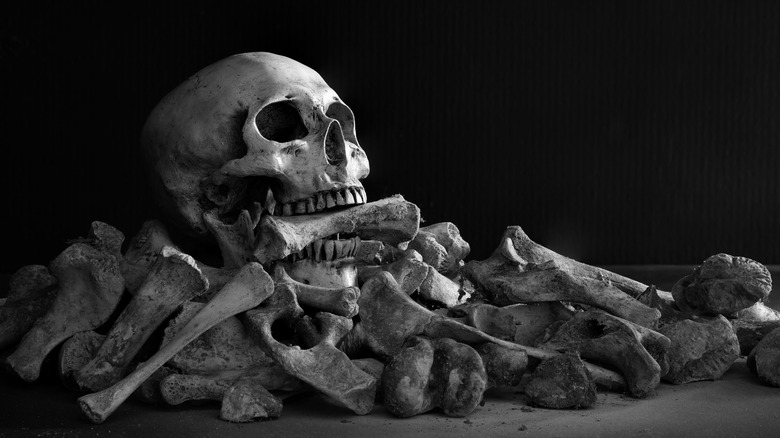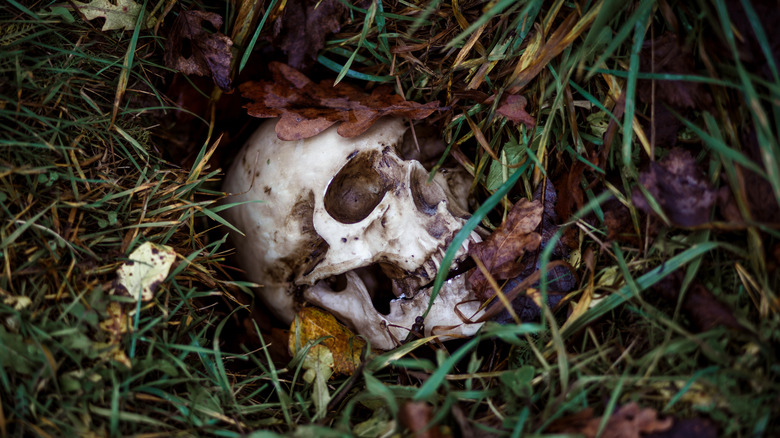The Oldest Human DNA Found Was Located In A Gruesome Place
Here's an up-front question for you: If you and your buddy were stranded on a frozen mountainside without food, and your buddy died, would you eat them? Not to be morbid or anything, but he might be an organ donor, anyway — provided you dig through all the fat and muscle. Gruesome? Of course. But far from being a mere thought experiment, this actually happened to plane crash survivor Piers Paul Read in 1972 in the Andes. He documented the whole thing in his 1974 book "Alive: The Story of the Andes Survivors," which was made into the 1993 movie "Alive."
That film wasn't the first or last of its kind. 1973's "Soylent Green" famously depicts a dystopian future — 2022, of all years — where an overcrowded, environmentally ravaged, and impoverished world subsists on little processed wafers from the Soylent Corporation. The wafers, of course, are made from people. On the comedic side of things, 1993's "Cannibal! The Musical" — written by "South Park" and "The Book of Mormon" creators Trey Parker and Matt Stone — retells the story of famed U.S. cannibal Alferd Packer. On the horrific side of things, 2016's coming-of-cannibal-age film "Raw" serves up some truly traumatizing imagery.
In the end, cannibalism acts as a kind of unbreachable moral barrier, beyond which dwells unhumans like Jeffrey Dahmer. But as it turns out, our vision of cannibalism is more modern than you might think. In fact, humanity's oldest DNA was found in the tooth of a cannibal.
A bit long in the tooth
The oldest human DNA on record was found back in 1994 in the Atapuerca Mountains in northern Spain. There, as Live Science recounts, archaeologists made a grisly discovery that doesn't necessarily rewrite the human story, but does cast it in a more horrifying light. Fossilized and buried human bones told a story of butchery, savagery, and the literal gnashing of teeth. Dating to about 800,000 years old and belonging to an as-yet-unclassified human ancestor dubbed "Homo antecessor," the bones showed signs of being "cut and fractured" as though cannibalized. And, one of the teeth of one of the victims itself contained remnants of human DNA. So yes, it indeed looks like some of our human ancestors were rolling around, clubbing each other to death, and then chowing down.
The reader might remember that we, Homo sapiens, are only the latest evolutionary model in a long line of now-extinct species. At present, as Smithsonian depicts, we know of at least 21 other human species that lived before us, dating back to our earliest progenitor — Sahelanthropus tchadensis — some 7 million years ago. Some of those species co-existed at the same time, like Homo sapiens and Homo neanderthalensis, the latter of which lived all the way from 400,000 B.C.E. to as recently as 40,000 B.C.E., side by side our own species. Homo antecessor, however, must have been short of protein and seemingly took to devouring other humans before being devoured themselves.
Decent calories per bite
So before you go condemning humanity as bearing the cursed lineage of a brutal, animal race — okay, never mind; feel free to make that judgment — it might pay to know that cannibalism might not have been uncommon in the days when Homo antecessor walked Earth. As Live Science says, early humans would have made quite the nutritious meal for other humans: lots of protein, decent amount of fat, pretty dumb at times (like us), and much easier to capture than something like a rhino. In terms of "calories per bite," humans would have provided a "moderately nutritious meal" for other humans. In fact, researchers estimate that human meals at the time might have accounted for a full 13% of the other humans' daily calories.
For us nowadays, this all comes across as despicable and disgusting, no matter how much of a rational choice it might seem for those in food-deprived times to dismember their neighbors and grab some table salt. While we can never know for certain whether or not those slaughtered and eaten were the target of the starved and desperate, some fringe cannibal cult, or just a casual Tuesday lunch, we can only hope that it was an absolutely last resort. On the bright side, as Live Science also says, Homo antecessor wasn't too, too related to our particular branch of the human tree, which includes Denisovans and the aforementioned Neanderthals. So cheer up, and be grateful for well-stocked grocery stores.


